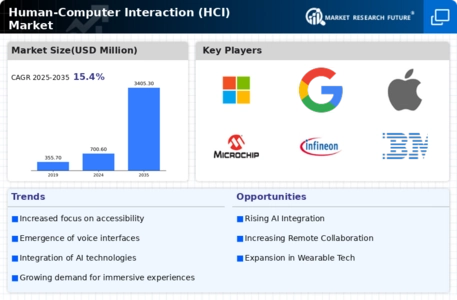Rise of Wearable Technology
The proliferation of wearable technology is reshaping the Human-Computer Interaction (HCI) Market. Devices such as smartwatches and fitness trackers are increasingly integrated with advanced sensors and interfaces, allowing for seamless interaction between users and technology. This trend is evidenced by a projected increase in the wearable technology market, which is expected to reach approximately 60 billion USD by 2026. As these devices become more sophisticated, they necessitate innovative HCI solutions that prioritize user experience and engagement. The demand for intuitive interfaces that can adapt to various contexts and user needs is likely to drive further advancements in HCI, fostering a more interconnected ecosystem of devices that enhance daily life.
Advancements in Cognitive Computing
Advancements in cognitive computing are poised to transform the Human-Computer Interaction (HCI) Market. Cognitive systems, which leverage artificial intelligence to simulate human thought processes, are becoming increasingly prevalent in various applications, from customer support to healthcare diagnostics. The cognitive computing market is expected to reach approximately 60 billion USD by 2025, highlighting the growing interest in these technologies. As cognitive systems become more sophisticated, they necessitate the development of HCI solutions that can effectively interpret and respond to user inputs. This evolution suggests a potential shift towards more adaptive and intelligent interfaces that enhance user interaction and engagement, ultimately redefining the relationship between humans and machines.
Emphasis on Data Privacy and Security
The increasing emphasis on data privacy and security is a critical driver in the Human-Computer Interaction (HCI) Market. As users become more aware of their digital footprints, there is a growing demand for HCI solutions that prioritize secure interactions. This trend is underscored by regulatory changes and heightened consumer expectations regarding data protection. Companies are now compelled to design interfaces that not only facilitate user engagement but also ensure the safeguarding of personal information. The HCI market is likely to see innovations that incorporate privacy-by-design principles, fostering trust and confidence among users. This focus on security may also influence the development of new interaction paradigms that balance usability with robust protection measures.
Growth of Virtual and Augmented Reality
The expansion of virtual reality (VR) and augmented reality (AR) technologies is significantly influencing the Human-Computer Interaction (HCI) Market. These immersive technologies are being adopted across various sectors, including gaming, education, and healthcare, creating new avenues for interaction. The VR and AR market is anticipated to surpass 200 billion USD by 2025, indicating a robust demand for HCI solutions that facilitate natural and intuitive user experiences. As users engage with digital environments in novel ways, the need for effective HCI frameworks that support these interactions becomes increasingly critical. This growth suggests a potential shift in how users perceive and interact with digital content, emphasizing the importance of designing user-centric interfaces.
Increased Demand for Natural Language Processing
The rising demand for natural language processing (NLP) technologies is reshaping the Human-Computer Interaction (HCI) Market. As users seek more intuitive ways to communicate with machines, NLP applications are becoming essential in various domains, including customer service, healthcare, and personal assistants. The NLP market is projected to grow to over 35 billion USD by 2026, reflecting a significant shift towards voice-activated and conversational interfaces. This trend indicates that HCI solutions must evolve to accommodate natural language interactions, enhancing user satisfaction and engagement. The integration of NLP into HCI frameworks could lead to more personalized and efficient user experiences, ultimately transforming how individuals interact with technology.


















Leave a Comment